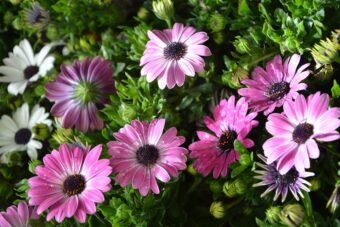In this article, we discuss how a green painted traditional coloured window box can be used to brighten up any gates. Green tends to recreate the colour of the leaves and is one colour that can be guaranteed to go well with any plant, you wish to use.

You can experiment with different shades from leafy greens, pale yellow-green, bronze-green, silvery sea-green to deep blue-green.
Be imaginative as you do have many plants of different shades and tints of green that you can use.
Team the container with plants whose leaves echo the shades that you have painted the window box in. This will add subtle yet interesting plant combinations that will work regardless of the flower shade used.
To accomplish what plants suit the paint you wish to use, paint an offcut of wood with some of the paint you wish to paint the window box in and take that to the garden centre to see what plants go well with the green you have chosen.
To add even more depth, you can add silver foliage plants to give extra dimensions to the window box. For a yellow-green box, cream-variegated leaves will accomplish the same goal, whilst red-bronze leaves look good in a green-bronze window box. For deep blue-green leaves such as hostas, will looks their best if they are planted in a blue-green window box. In this scheme, colour matching will make the plants within the window box more elegant.
You have two options when planting the plants in the wooden window box, you can either plant directly into the growing media directly or they can be left in their own pots and the pots planted inside the window box.
The second option allows the display to be changed when you feel like a change or when the plants within is beyond their best.
Proper planting does not have the flexibility of altering the displays when you feel like it, but it has the great advantage that less watering is required, as there is a much greater volume of compost in the window box. This makes it take longer to dry out, which is better if you are away from your home a lot, as this is easier to take care of.
CREATING AN OSTEOSPERMUM DISPLAY IN A GREEN WINDOW BOX
First, as ever you will need to make a wooden window box as described in my previous article on how to do this. Once completed, you will need to paint the inside and outside a silvery-green colour using a wood stain.
Buy a green trough that will fit inside the window box. To the bottom of the trough drill multiple holes to allow water to drain out. This is essential as most of the plants used hate being waterlogged which can lead to root rot. The window box that is created has no bottom wood panel but two roof lathes acting as struts to help drain the water away more efficiently.
This prevents it from rotting when the trough is watered or when it rains.
Fit the trough in place and then fill it to within 5cm of the top with a mixture of 25% gravel and 75% multipurpose compost. This will leave room to plant 9 plants in, using a trowel to make room to make a hole for the plants. In the display I suggest, 3 pink-flowered Osteospermum will be used with 6 silvery Senecio cineraria. This is enough to fill the whole display up.

Place the best and darker coloured Osteospermum in the centre of the display, as this will attract the eye to it. If you use it at one end with a paler Osteospermum elsewhere, it will make the scheme look lopsided.
Plant the paler Osteospermum at each side at an equal distance from the centre and edges to form a tight group. It is best if the flowers mingle enough together to appear to be different shades of the same plant to complete a natural look.
At each end of the window box plant the silvery Cinerarias in a clump of three. Spacing them so that they fill any remaining spacing at equal distances. Angle them outward slightly so that they grow outwards over the edges of the window box.
Fill up the gaps left between the plants with more of the growing media mixture and firm them in. This will make more room for the roots to grow in.
It will now have a slightly domed shape, which looks as if the plants have been there for a long time and looks natural. As with other window box displays, you will need to water and feed regularly throughout the growing season.
WINDOW BOXES IN THE SUN OR IN THE SHADE?
Most window boxes will either get direct sunlight for only half the day or less, which is fine for most bedding plants. In the hot sun, Mesembryanthemum and herbs such as thyme and sage will thrive. Impatiens and Fuchsias actually prefer some shade from the strong sunlight. Petunias are one of the most reliable, free-flowering plants for summer display but they do take some looking after. To keep them at their best you will need to provide them with some shade from the midday sun, frequent watering, deadheading and frequent feeding with a liquid fertilizer.

For deeper shade, try using trained box and ivies to give a classic-style window box display. Variegated foliage plants and violas will thrive in the shade, where the sun will not scald the leaves. You must be aware when you plant any window box of these potential problems where a green painted window box will look the best in either full sun or deep shade.
CONCLUSIONS
In this article, we have discussed how a green painted window box can be used to give a stunning window box display in either full sun or deep shade.
You have a large choice of plants that can be used to give an elegant display in spring to winter, in full sun or deep shade.
One theme of creating a window box painted in green that is planted with Osteospermums and Cinerarias to give an instant impactful display has been demonstrated.
Green is such a useful colour to which to paint your window box in, as you have some choice to the flowers and foliage plants that can go inside them. I have only scratched the surface, but I hope you release the potential green window boxes can bring to your display.
If you have any questions or comments that you have on this topic, please do so in the comment box below.
Happy window box gardening.
